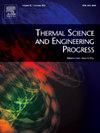电池模块主动平衡-低温自热集成拓扑和控制
IF 5.1
3区 工程技术
Q2 ENERGY & FUELS
引用次数: 0
摘要
为了解决传统电池模块平衡和低温自加热系统拓扑结构复杂、能效低的局限性,本研究提出了一种结合两者功能的新型集成拓扑结构。提出了协调控制策略,以增强主动平衡和自加热之间的协同作用。仿真结果表明,增大PWM信号周期可以显著提高平衡速率和自热速率,而同时调整电感和周期的影响有限。所提出的主动平衡策略使Buck-Boost转换器能够在间歇电流模式下工作,在串联电池之间实现快速的充电状态均衡。此外,变周期自加热策略在加热效率上优于定周期自加热策略,并且更高的极限电压进一步加速了加热过程。这些发现证明了所提出的方法在实现在寒冷气候条件下运行的电池模块的高效和紧凑的电热能量管理方面的潜力。本文章由计算机程序翻译,如有差异,请以英文原文为准。
Battery module active balancing-low temperature self-heating integrated topology and control
In order to address the limitations of traditional battery module balancing and low-temperature self-heating systems, which are often associated with complex topologies and low energy efficiency, a novel integrated topology that combines both functions is proposed in this study. Coordinated control strategies are developed to enhance the synergy between active balancing and self-heating. Simulation results show that increasing the PWM signal period significantly improves both the balancing and self-heating rates, while simultaneous adjustment of inductance and period has limited impact. The proposed active balancing strategy enables the Buck-Boost converter to operate in intermittent current mode, achieving rapid state-of-charge equalization across series-connected cells. In addition, the variable-period self-heating strategy outperforms constant-period approaches in heating efficiency, and a higher limiting voltage further accelerates the heating process. These findings demonstrate the potential of the proposed approach to achieve efficient and compact electro-thermal energy management for battery modules operating in cold climate conditions.
求助全文
通过发布文献求助,成功后即可免费获取论文全文。
去求助
来源期刊

Thermal Science and Engineering Progress
Chemical Engineering-Fluid Flow and Transfer Processes
CiteScore
7.20
自引率
10.40%
发文量
327
审稿时长
41 days
期刊介绍:
Thermal Science and Engineering Progress (TSEP) publishes original, high-quality research articles that span activities ranging from fundamental scientific research and discussion of the more controversial thermodynamic theories, to developments in thermal engineering that are in many instances examples of the way scientists and engineers are addressing the challenges facing a growing population – smart cities and global warming – maximising thermodynamic efficiencies and minimising all heat losses. It is intended that these will be of current relevance and interest to industry, academia and other practitioners. It is evident that many specialised journals in thermal and, to some extent, in fluid disciplines tend to focus on topics that can be classified as fundamental in nature, or are ‘applied’ and near-market. Thermal Science and Engineering Progress will bridge the gap between these two areas, allowing authors to make an easy choice, should they or a journal editor feel that their papers are ‘out of scope’ when considering other journals. The range of topics covered by Thermal Science and Engineering Progress addresses the rapid rate of development being made in thermal transfer processes as they affect traditional fields, and important growth in the topical research areas of aerospace, thermal biological and medical systems, electronics and nano-technologies, renewable energy systems, food production (including agriculture), and the need to minimise man-made thermal impacts on climate change. Review articles on appropriate topics for TSEP are encouraged, although until TSEP is fully established, these will be limited in number. Before submitting such articles, please contact one of the Editors, or a member of the Editorial Advisory Board with an outline of your proposal and your expertise in the area of your review.
 求助内容:
求助内容: 应助结果提醒方式:
应助结果提醒方式:


